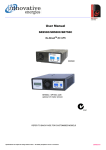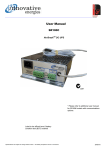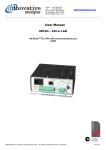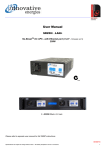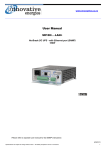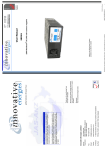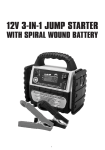Download SR500i-LAN+(SNMP)
Transcript
User Manual SR500i….LAN+ No-BreakTM DC UPS with Ethernet / SNMP comms. port 500W (optional V/I meter shown) Please refer to separate user manual for full SNMP instructions Specifications are subject to change without notice. No liability accepted for errors or omissions. 23/01/15 Safety The user is responsible for ensuring that input and output wiring segregation complies with local standards and that in the use of the equipment, access is confined to operators and service personnel. A low resistance earth connection is essential to ensure safety and additionally, satisfactory EMI suppression (see below). HAZARDOUS VOLTAGES EXIST WITHIN A POWER SUPPLY ENCLOSURE AND ANY REPAIRS MUST BE CARRIED OUT BY A QUALIFIED SERVICEPERSON. Electrical Strength Tests Components within the power supply responsible for providing the safety barrier between input and output are constructed to provide electrical isolation as required by the relevant standard. However EMI filtering components could be damaged as result of excessively long high voltage tests between input, output and ground. Please contact our technicians for advice regarding electric strength tests. Earth Leakage The EMI suppression circuits causes earth leakage currents which may be to the maximum allowable of 3.5mA. Ventilation High operating temperature is a major cause of power supply failures, for example it has been well documented that a 10oC rise in the operating temperature of a component will halve its expected life. Therefore always ensure that there is adequate ventilation for the equipment. Batteries and cooling fans also suffer shortened lifetimes if subjected to high ambient temperatures - both should be included in a routine maintenance schedule to check for signs of reduced efficiency. Water / Dust Every effort must be made in the installation to minimise the risk of ingress of water or dust. Water will almost always cause instant failure. The effects of dust are slower in causing failure of electronic equipment but all electrical equipment should be cleaned free of any dust accumulation at regular intervals. This is particularly important where internal fans are fitted. Electromagnetic Interference (EMI) Switching power supplies and converters inherently generate electrical noise. All wiring should be as short as practicable and segregated from all equipment wiring which is sensitive to EMI. Residual noise can be reduced by looping DC wiring through ferrite cable sleeves. These are most effective as close to the power supply as possible and as many turns of the wire taken through the core (+ and - in the same direction) as the core will accommodate. Fuse ratings Check that the wiring and fuses or MCBs match the rating of the PSU or converter. Adequate fuse protection of battery circuits is very important owing to the large potential currents available from batteries. Our No-Break DC series has an internal ECB for protection of the battery circuit but for all other charging situations should have an external fuse or circuit breaker fitted in the battery circuit. Connection polarity It is critical to check the polarity carefully when connecting batteries and equipment to DC power supplies and chargers. Boost chargers (and some float chargers) made by Innovative Energies have reverse polarity protection, which can be by an electronic switch (non-destructive) or an internal fuse which needs to be replaced if a battery is connected in reverse. Glossary of terms used in our user manuals PSU = power supply unit BCT = battery condition test ECB = electronic circuit breaker ELVD = electronic low voltage disconnect RPP = reverse polarity protection EMI = electromagnetic interference SNMP = Simple Network Management Protocol LAN = local area network Specifications are subject to change without notice. No liability accepted for errors or omissions. 2 INTRODUCTION The No-Break ™DC power supply is designed to provide DC power to lead acid batteries for critical back up applications. In addition to the normal features of the standard SR750C.. model, the SR750i.LAN+ has an ethernet communication interface using SNMP protocol to enable user monitoring of the power supply and battery parameters and control of the battery condition test function. No-Break™ SYSTEM BLOCK DIAGRAM Ethernet port OPERATION OF ELECTRONIC CIRCUIT BREAKER (ECB) FOR PROTECTION OF BATTERY CIRCUIT Max. allowable load amps (x I rated) Max. allowable load amps (x I rated) INPUT POWER OFF 8 8 INPUT POWER ON Short circuit condition, ECB trips within 2ms Short circuit condition, ECB trips within 2ms 7x I rated for 300ms max. 7 6x I rated for 300ms max. 6 2.5 x I rated peak current allowed 1.5 x I rated until LV disconnect operates 2.5 1.5 2ms ECB automatically resets 300ms Time IPSU = 1x I rated IBAT = 1.5x I rated 2ms ECB trips & latches off until input power is restored 300ms Time IPSU = 0 IBAT = 1.5x I rated The ECB will operate on overcurrent as above & is also activated for the low voltage disconnect function on mains fail (no input power). It will reset when input power is restored, or can be manually reset by briefly shorting the BAT- and LOAD- terminals together when there is no input power. Specifications are subject to change without notice. No liability accepted for errors or omissions. 3 CONNECTION DIAGRAM CONNECTION & INITIAL TESTING 1 Check input and output voltages of system, ensure that they match the equipment. All loads should be isolated. 2 Check polarity of all wiring. Place temperature sensor probe near or on batteries. 3 Plug in input power. “POWER OK” LED will light up. DC output voltage should appear at both load and battery outputs. 4 Turn off input power. 5 Connect battery. 6 Check that ECB (internal electronic circuit breaker) closes by shorting together the BATTERY –ve and LOAD –ve terminals briefly. Both LEDs will light up. If this does not happen, there is a fault in the wiring or the internal battery protection fuse is ruptured (see Note 2 below). The battery voltage will then appear at the load terminals and the “BAT LOW” alarm relay energises. The “POWER OK” LED stays on for about 30 seconds. 7 Connect load wiring to LOAD+ and LOAD- terminals. 8 The system is now ready for operation. 9 Please refer to separate user manual for setting up the SNMP web interface. NOTES 1 2 3 4 Maximum current available with input power present: 2.5 x rated PSU current with no input power: 1.5 x rated PSU current Reverse polarity protection If the battery is connected in reverse, the internal battery protection fuse may be ruptured and the unit should be returned to the manufacturer for repair. If the fuse is good, the voltage measured as at step 3 above should be exactly the same on both the load and battery outputs. Battery Condition Test (BCT) BCT function is disabled on start up and is controlled via the SNMP interface. BCT fail reset If the system fails a BCT the BAT LOW alarm latches (de-energized state) until either: both the mains power input and the battery are disconnected briefly or: the system passes the next BCT. Specifications are subject to change without notice. No liability accepted for errors or omissions. 4 DIMENSIONS CONNECTION LAYOUT Stud terminals POWER INPUT TEMPCO + COM LOAD- ALARMS BATTLAN NOTE: LOAD+ / BATT+ terminals are linked internally and are connected to the +COM terminal FRONT PANEL LEDS (WITH BUILT IN SWITCHES) For full list of LED flash codes please refer to page 7. BATTERY SYSTEM OK: LED on: Battery present and above V batl. POWER OK: LED on: Input power present STANDBY: LED on: Charger in standby mode (no output from charger) Warning: Do not put unit into standby mode during normal operation as “BATLOW” alarm and low voltage disconnect are both disabled. ALARM RELAYS AUX: Relay is energized when the battery condition test is in progress MAINS FAIL: Alarm indicates loss of input power after 30 sec delay. BAT LOW: Relay is de-energized when either: 1. battery voltage = 1.8V/cell (for 2V cells) - operates only when no input power present or 2. battery missing or fault in battery circuit wiring (alarm does not activate for up to battery detection interval time). Specifications are subject to change without notice. No liability accepted for errors or omissions. 5 SPECIFICATIONS (at 20 degrees C) Nominal Voltage Parameter Default Value 12V 24V 30V 36V 48V *1 V out = Output voltage 13.8 27.6 34.5 41.4 55.2 2.3V/cell V pres = Voltage threshold for battery detection & battery condition test (BCT). If voltage drops to this level during BCT then the test is aborted and BATT SYS OK relay deenergises 12.2 24.4 30.5 36.6 48.8 2.03V/cell 11.5 23 28.8 34.5 46 1.92V/cell 11 22 27.6 33 44 1.84V/cell 10 20 25 30 40 1.66V/cell V shutd = Output voltage of PSU during battery detection & BCT V batl = Battery low alarm voltage during mains fail. (BATT SYS OK alarm relay de-energizes) V disco = Battery disconnect voltage during mains fail Bccl = Maximum charge current as % of rated PSU rated current *2 Comms = communications mode of PSU: F = continuous data stream of status M = responds only to request made by a controller M BatDetect = Battery detection interval time, active only when no battery charge current is detected (the unit may not detect a missing battery for up to this time) 60 min BCT = length of battery condition test 20 min Ret = retest option: N = after a failed BCT further scheduled BCTs are inhibited Y = after a failed BCT further scheduled BCTs will be allowed Y CC = Length of charge cycle in minutes/hours/days. ie. time between battery condition tests 40m/23h/ 027d MfiBCT = time before mains fail check during BCT. A mains fail during a BCT will stop the BCT. If set longer than BCT time no mains fail check will occur. 30 min NOTES: *1 Output voltage is set by an internal potentiometer. *2 Refer to ‘PSU Configuration’ page on website Specifications are subject to change without notice. No liability accepted for errors or omissions. 6 LED INDICATION CODES Battery Power OK System OK LED LED Stand-by LED Battery System OK Alarm Power OK Alarm Normal Normal System Normal: Input power on, battery circuit is OK Normal Normal Battery detection test in progress Alarm Normal Normal Alarm Input power off, battery system is OK (battery volts > Vbatl) Alarm Alarm Input power off and battery has discharged to < V batl Alarm Alarm Input power off, ELVD has activated and disconnected battery from load. Normal Normal BCT is in progress: LEDs flash slowly Alarm Normal Input power on, battery condition unserviceable- battery voltage < Vpres during a BCT Normal Normal PSU in standby, input power on, battery system OK Alarm Alarm Alarm Normal Condition Input power on, battery system fault: LEGEND : =on =fast flash 1. 2. Internal battery fuse has opened or Battery circuit wiring open circuit, battery missing, ECB has tripped PSU in standby, input power present, battery missing. PSU in standby and system has failed previous BCT =slow flash Specifications are subject to change without notice. No liability accepted for errors or omissions. =off 7 With Ethernet (SNMP) communication port • Remote monitoring of DC system via internet connection • BCT controlled via web page or SNMP MIB browser • Includes all the features of our standard No-Break DC UPS systems • Separate outputs for load and battery • Battery detection - regular battery presence and battery circuit integrity checks • Deep discharge protection for battery • ECB for overload protection of battery circuit • Fused reverse battery polarity protection • Automatic temperature compensated output volts • No-Break switching between PSU & battery • LED flash codes for precise state indication • Two alarm relay outputs standard + BCT relay Optional internal V/I meter shown ♦ 24 Month Warranty SPECIFICATIONS All specifications are typical at nominal input, full load and at 20°C unless otherwise stated. ELECTRICAL No-Break™ FUNCTIONS AND ALARMS* AC Input 230V AC: 180V - 264V (standard) 110V AC: 88V - 132V (on request) Battery Charge Limit See Model Table for default settings may be increased to PSU rated current Frequency 45- 65 Hz Reverse Polarity Battery reverse connection will open internal fuse (and produce alarm) Fusing / Protection Input fuse Output fuse & ECB for battery Battery Monitoring Detects for presence of battery on start up, then every 60 minutes when charge current < 200mA Electronic Circuit Breaker (ECB) operates under the following conditions: • battery voltage drops to 1.67V/cell auto reset • < 300ms for load > 6 x rated PSU current, allows ~1.5x rated PSU current from battery without acting, • < 2ms, backed up by fuse Isolation 1KV DC input - output / earth Efficiency > 85% Battery Protection Inrush current Soft start circuit - low battery volts Output Power 500W Output Voltages 13.8, 27.6, 34.5, 41.4, 55.2V Voltage adj. range 85 - 105% of Vout Temp. Compensation Temperature sensor on 1.7m lead with adhesive pad: -4mV / °C / cell ±10% Indication LEDs Green: Battery System OK, Power OK Red: Standby PSU: 100% rated current Battery: 25-100% PSU current Alarms • Current Limits Line Regulation <0.2% over AC input range Load Regulation <0.4% open circuit to 100% load Noise <1% Drift 0.03% / °C Hold-up time 15 - 20 ms (nom. - max. Vin) without battery Thermal Protection Yes, self resetting OVP Over-voltage protection on output at ~ 130% of nominal output voltage Battery Condition Test (BCT) Default setting: 20mins/28 days. Control of BCT is implemented using the SNMP software. Please do not hesitate to ask our sales staff for assistance with this feature. - overload - short circuit Alarm Relay contacts Standby Mode Power OK (Mains/PSU fail, standby mode) • Battery System OK - alarms when battery voltage low (on mains fail) , battery missing, battery circuit wiring faulty, BCT fail (if enabled) C - NO - NC full changeover rated 1A /50V DC, 32VAC Turns off DC output of PSU & allows load to run off battery ENVIRONMENTAL Operating temperature 0 - 50 °C ambient at full load De-rate linearly >50 °C to no load @ 70 °C Storage temperature -10 to 85 °C ambient Humidity 0 - 95% relative humidity non-condensing Cooling Fan cooled STANDARDS EMI to CISPR 22 / EN55022 class A Safety to IEC950 / EN60950 / AS/NZS3260 Specifications are subject to change without notice. No liability accepted for errors or omissions. 8 500 Watt No-Break™ DC charger for lead acid batteries STANDARD MODEL TABLE *1 charge current limit may be varied at time of order *2 to allow for adequate charging current DC Output MODELS Output (V) PSU Rated (A) Charge Limit (A) *1 Recomm. Load (A)*2 Peak load on input fail (A) SR500i 12 13.8 36 36 27 54 SR500i 24 27.6 18 18 12 27 SR500i 30 34.5 14.5 14.5 10 21.5 SR500i 36 41.4 12 12 7 18 SR500i 48 55.2 9 9 5 13.5 SCHEMATIC BLOCK DIAGRAM PHYSICAL AC Input connector IEC320 inlet socket DC Output Connections M8 brass stud or plug-in/ screw terminal block (20A/ terminal) Alarm Connections Plug in/ screw terminal block Enclosure Powder coated steel Weight 4.3kg Dimensions 225W x 304D x 70H mm (excluding mounting feet and terminals) OPTIONS 19”Rack Mount 2U sub rack option: add SR-RM2U Optional V/I meter for subrack: SR-METER Wall Mount Enclosure PSU may be fitted into enclosure with MCBs and terminals. Code: SEC-SR Parallel redundancy Use external output diode, eg +P50. Please refer to separate application notes. Internal Digital V/I Meter Add code +INT-METER ACCESSORIES SUPPLIED Mounting feet together with screws AC power cord 1.5m with IEC320 socket & AUS/NZ plug Mating screw terminal plug for DC connector for ‘X’ version Mating screw terminal plug for alarm outputs Crimp lugs for ’S’ version MODEL IDENTIFICATION CODES Communication port: LAN+ = Ethernet (SNMP) Input voltage and front panel standby switch: 230V AC 110V AC 110V DC Output DC Connector type: Stud = S Cooling Fan cooled = F + switch = L 230V AC + switch = U 110V AC + switch = H 110V DC no switch = blank no switch = G no switch = J Phoenix combicon (plug in /screw terminal block) = X Temperature Compensation Yes = T DC output: Nominal voltage 12, 24, 30, 36, 48V Function i = No-Break™DC with communication port Power 500W Specifications are subject to change without notice. No liability accepted for errors or omissions. No = blank 9 #1 1 x No-Break™DC charger and 1 x battery bank #2 1 x No-Break™DC charger and 2 x battery banks This is the basic connection which is most commonly used, and provides adequate protection for the majority of systems requiring DC back up in the event of a mains power failure. The SR250xxxV No-Break™DC UPS is designed to provide superior battery backup availability without having to use two power supplies. Dual battery banks and automatic battery condition testing reduce the risk of battery failure for critical applications. Alarms Available Single battery DC backup system Alarms Available Power OK YES Battery Missing YES Battery Low YES Battery Condition Test Fail YES N+1 redundancy for batteries Power OK YES Battery Missing (B1&B2) YES Battery Low (B1&B2) YES Battery Condition Test Fail (B1 & B2) YES #3 2 x No-Break™DC chargers and 2 x battery banks #4 No-Break™DC Connection for high peak loads 2 x No-Break™DC chargers connected in parallel with separate battery banks & output diodes. This solution provides an extremely high level of redundancy for very critical applications, with redundancy of the battery in addition to the power supply. The diodes isolate the units from one another in the event of a short circuit appearing at the other output and aid current sharing. This is a basic connection which is used when there is a connected load with a peak current greater than 1.5 times the rated current of the charger. Standing loads are connected normally and an optional external low voltage disconnect may be used for the peak load. Alarms Available N+1 redundancy for charger and batteries Alarms Available YES Power OK YES Battery Missing YES Battery Low *1 interlock circuit required for automated BCT 1 Battery Condition Test Fail* Single battery DC backup system for peak loads YES Specifications are subject to change without notice. No liability accepted for errors or omissions. Power OK YES Battery Missing YES Battery Low YES Battery Condition Test Fail YES 10 #5 N+1 for No-Break™DC charger and single battery bank #6 N+1 for No-Break™DC charger and N+1 for battery bank (use this connection for high peak loads) This connection provides for redundancy of the charger and retains most of the No-Break functions. All No-Break alarms are available and the low voltage disconnect for the peak load is optionally implemented with an external relay. Alarms available *1 interlock circuit required for automated BCT Alarms available Power OK YES Battery missing NO YES Battery low Battery condition test fail* 1 *2 interlock circuit required for automated BCT YES Power OK YES Battery missing YES YES Battery low Battery condition test fail * 2 YES Standard N+1 redundant DC connections #7 Standard AC/DC power supplies with alarms and external diodes #8 Standard AC/DC power supplies with internally fitted diodes (applies only to SR100P and SR250P models with outputs >12VDC) Specifications are subject to change without notice. No liability accepted for errors or omissions. 11 TERMS OF WARRANTY Innovative Energies Ltd warrants its power supplies for 24 months (two years) from date of shipment against material and workmanship defects. Innovative Energies' liability under this warranty is limited to the replacement or repair of the defective product as long as the product has not been damaged through misapplication, negligence, or unauthorized modification or repair. Thank you for purchasing from Innovative Energies. We trust your power supply will exceed your expectations and perform for years to follow. Sincerely, The Innovative Energies team. Innovative Energies Limited Phone: Freephone: +64 9 835 0700 0800 654 668 (New Zealand) 1800 148 494 (Australia) Fax: +64 9 837 3446 Email: [email protected] Online: www.innovative.co.nz or www.innovative-energies.com In Person: 1 Heremai Street, Henderson, Auckland, New Zealand By Post: PO Box 19-501, Auckland 1746, New Zealand













